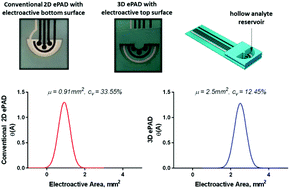A three-dimensional electrochemical paper-based analytical device for low-cost diagnostics†
Abstract
Paper-based microfluidic devices with screen-printed electrodes (SPEs) for electrochemical sensing are popular for low-cost point-of-care diagnostics. The electroactive sensing area in these devices is always the irregular, bottom-SPE surface which is in contact with the analyte flowing within the paper substrate. Unfortunately, this results in an electroactive area which varies widely from sensor to sensor. In this paper, we present a three-dimensional paper-based analytical device with a hollow 3D fluid reservoir which allows for use of a more uniform top-SPE surface as the electroactive sensing area. The use of this isolated reservoir eliminates the need for dielectric inks used in conventional SPEs on paper. Our sensors are fabricated using a combination of wax-printing, screen-printing and simple folding via a cleanroom free process without the need for expensive equipment. Additionally, for the first time, we demonstrate an electrochemical paper-based analytical device with a custom designed potentiostat integrated circuit (IC) as a miniaturized reader. The versatility of the sensor is demonstrated through voltammetric, amperometric and potentiometric measurements of important biochemical analytes such as dopamine, glucose and pH. The 3D ePAD together with a custom CMOS potentiostat demonstrates a low-cost, versatile, self-contained system suitable for point-of-care diagnostic devices.



 Please wait while we load your content...
Please wait while we load your content...